This page is an automated translation of /nl/panamacanal.html and is awaiting a manual review.

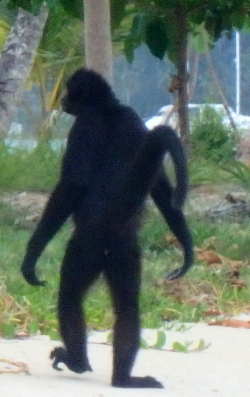
We leave Kuna Yala with a heavy heart, but we are curious about what the rest of Panama has to offer. Linton Island is located about halfway between San Blas and the entrance to the Panama Canal, making it a convenient place to divide the journey into two day trips. A few monkeys live on Isla Linton and those monkeys have taken possession of an abandoned mansion that is right on the edge of the anchorage. The monkeys are used to people because the sailors sometimes feed the monkeys. Reportedly, the monkeys eat out of control and even sit on your lap, but as soon as you start to leave, the monkeys get upset and often engage in aggressive behavior. We hear a lot of biting incidents (to the bone) so we decide not to go ashore on the island. We do sail right past it, and when we show a monkey hanging in a tree from the dinghy, the monkey comes down quickly. We throw the banana on the beach and watch the monkey eat the banana and the other monkeys curiously come running. These spider monkeys can walk upright just like humans and that looks very funny.
In the meantime, we read through the information about the Panama Canal again. The Panama Canal is a milestone for every world sailor. It separates the Atlantic and the Pacific and prevents you from having to sail all the way around South America to get to the other side. Now South America is definitely worth a visit, but it doesn't fit the timetable, you would have to leave the tropics and sail into the winter of the Southern Hemisphere with bad weather, countercurrents, headwinds, fog, very hard wind, and so on. So almost every world sailor goes through the Panama Canal.
Five hundred years ago, the first plans to dig a canal through the narrow part that connects North and South America were started. The only problem is that the ground is very hard and that the lowest part of the shortcut still protrudes 27 meters above sea level. It therefore took until the end of the 19th century before an attempt to actually build the Panama Canal was started. The first to try this were the French, but they suffered capital losses in both men and money and eventually gave up. Years later, the Americans picked up the thread and in 1914 the Panama Canal opened. The Panama Canal is also referred to as one of the Seven Wonders of the World: Three enormous locks have been built on each side that are more than 300 meters long and allow the ships to bridge the height difference of 27 meters. It's a busy and popular route: 10,000 people work continuously in the canal company and it provides half the income of all of Panama.
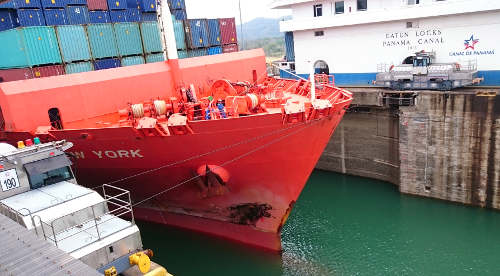
The Panama Canal was not built for sailing boats but for gigantic container ships. The sailing boats that want to circumnavigate the world are a very small minority and they do that. Literally, because the sailing boats have to enter the lock together with such a container ship. Once the lock gates are closed and the water from the lake is let into the lock, a swirling mass of water is created, partly due to the fact that the mixing of the heavier salt water with the lighter fresh water creates all kinds of strange but also powerful currents. The sailing boats are usually tied together with three pieces to form a kind of raft and by means of long lines that are tied above the lock, the intention is to keep the entire raft under control and to prevent the boats from hitting the lock wall or the container ship. be smacked. Now tying the boats with long lines is an obvious solution, but a complication is, of course, that the water level in the lock rises (or falls) by 9 meters and the lines have to be constantly caught up or down. And for that you need "line handlers", people who operate the lines and ensure that they do not get tangled, that the boat does not get caught on a line, or that the line becomes so long that the boats still smack against the shore . The line handlers do this operating the lines on the instructions of the pilot who will also get you on board. The boats must also be hung with tires and/or fenders so that they do not get damaged by a light touch. It all sounds very exciting.

The next morning we anchor again from Isla Linton and sail to Colon, the harbor where the entrance to the Panama Canal is located. The closer we get, the more tankers, container ships and other large equipment we encounter. Strangely enough, our guide does not say anything about the procedure to be followed so we only slalom a little between the large ships and call up Christobal Signal Station near the imposing 30 meter high red and green markings of the harbor entrance. This states that we can continue sailing as long as we watch out for the large ships that sail there! On our map an anchorage area is indicated for "small craft" and we expect to find an anchorage there that is full of sailboats that also want to cross the Panama Canal. But strangely enough the anchorage is completely empty! It is already later in the afternoon and we decide to drop anchor anyway; we have to be here to be measured to pass the channel. But shortly after we arrive there suddenly some sailboats arrive that, unusually for an anchorage, have fenders hanging around. We take the dinghy along the boats, they all turn out to be boats that will enter the Panama Canal tonight and have to wait here at this anchorage for the pilot who will get them on board. All these people are very certain that we should hire an agent to take care of everything. One tells us that there was someone who tried to handle the formalities on his own and that he was finally able to get through the Panama Canal three weeks later. We will not give up immediately, however, because we have heard that it can be done without an agent and that quickly saves three to five hundred dollars. There is also a boat arrived without fenders, unfortunately a French boat, but we decide to have a chat anyway. The people on this boat are surprisingly nice and speak good English and say that they have just arrived, just like us, but that they of course have an agent and will get the "admeasurer" on board tomorrow morning to measure the ship and fill it in. of the papers. The "admeasurer" measures the ship as this determines the rate, observes the ship and provides instructions on how to prepare the ship for transit through the Panama Canal. The process can only be started once the admeasurer has completed the papers. It is therefore important for us to get the admeasurer on board as soon as possible and that is why Ilona had already filled in a necessary form in Bonaire and e-mailed it to the organization. All we have to do is tell us that we have arrived at the intended place. Ilona sends that email and actually receives an email at night that an admeasurer will be on board in the morning! Hoera! The admeasurer find our boat awfully sturdy and good but we need a certificate (like everyone else) signs that our boat on is appropriate for the Panama Canal but we do through want, and we get the papers which we need for the bank to to arrange payment.

The French know an alternative anchorage where there is a possibility to come ashore with the dinghy: Club Nautico. This is also the place where we can conveniently meet up with Tito. Tito is the one we called because we read all over the internet that this is the right person to rent car tires and long lines. We follow the French to this place and go ashore when Tito calls us that he is there. We sit at a terrace table of the restaurant and we do business smoothly: We rent eight car tires and four long lines, he can provide us with a fumination report for the Galapagos Islands (where we may go on the other side of the Panama Canal) for only 50 dollars instead of the current price of $ 250, and line handlers for $ 85 each. We keep those line handlers in reserve for a while, because there are other ways to get line handlers. The agent hired by the French joins us because it is related to Tito. The French come in and they get the information from their agent that we just got from Tito for free. The agent of the French offers line handlers for $ 100 per person and at the end of the conversation we see an envelope with the contents of the agent going to Tito, because in the end it is Tito who delivers the line handlers, but for 85 dollars each. This way, the agent also earns a little extra. We are glad we did not hire an agent because it is a real money mite that is useless and everyone in this circus is trying to rake in as much money as possible.

Tito strongly advises against entering the city of Colon on our own. He is very certain that we should go through the Panama Canal as fast as we can because on the other side, Panama City, it is much cozier, safer and more beautiful. If we do have to do something here in Colon, we better hire a taxi driver and he will arrange a taxi for us on the spot who will show us the locks, go with us to the supermarket so that we can do some shopping and make sure we get to somewhere can withdraw money from a bank. Taxis are cheap in Panama! The question is whether we will make it because the rear tire of the taxi is slowly deflating, but when I point it out to the driver, it seems to be a known problem. The taxis, like so much stuff in Panama, are mostly hand-me-downs from America. The priority system seems complicated at first, but a little later I discover how it works: the cars with the most dents are allowed first. In itself logical, the more dents the longer you have been driving around and the more rights you have acquired. And an abundance of dents means you won't mind taking another dent so the less dented ones will happily let you go. The system is clear, logical and self-regulating. We always reach for our seat belts, only there are no seat belts here so we just have to get used to how things are going here. (Later we hear from one of our Panamanian line handlers that his mother bought him a driver's license for $ 100 as a surprise, so that is how it works here and it makes sense that no traffic rules are followed if no one has ever had to learn them.)
During our trip we have already seen many countries that are less prosperous than the Netherlands. But until now these were countries where they have a cheerful kind of poverty, where they build nice huts with less money, have parties for good fishing, where the people are generally cheerful. But what we find here in Colon, we were not prepared for that. It is a disconsolate mess, everything is in disrepair, the human warehouses are about to collapse, there is junk everywhere in the street, gangs of robbers seem to rule here. In the better neighborhoods, large walls surround the plots, sometimes around entire neighborhoods, with rolls of barbed wire on top as if they were prison camps. All windows are fitted with thick bars. There are also numerous security guards in the supermarket. And at the bank you will first be scanned with a metal finder before you can enter. I think the difference stems from the fact that in the poorer countries we first saw, people were still able to catch a fish, pick a banana, pick a coconut, and build a bamboo hut. Prosperity was for the perks. No money this month? Phew, life just goes on. However, the people of Colon cannot catch fish, collect coconut, and build a hut. They need money to provide for their very first necessity of life "food" and money to provide for the second "a roof over your head". No money this month? Too bad; starving and losing your shelter. They are trapped in a capitalist system with no way out and desperately try everything to get money and hang around in the city because that is the best chance of a job.
The next morning is Monday and we can finally go to the bank to pay for our Panama transit. Of course we hire our regular private driver again (as early in the day his rear tire turns out to be tight) and for 5 dollars he fetches and takes us to and from the bank and waits patiently there. Around noon we call the scheduler and appear to be scheduled for Thursday evening. A little later than expected but it seems to be busy. The French also call, but it turns out that they are only allowed through the channel on Friday. They are not happy; they got there earlier than us, had hired a special agent to make everything run smoothly, but now they are only allowed through the channel later than us.

In the meantime, we have arranged with another boat to have one of them join us as a line handler, and we also found a young Panamanian couple via the internet who would like to take a trip through the Panama Canal and act as a line handler for that. It costs us nothing and the couple has a nice trip! We are now done with all the arrangements and we decide to leave the anchorage to go to the Rio Chagres. We got this tip a long time ago on the Tobago Cays from an Israeli couple and it turns out to have been a golden tip. The river is six miles away - an hour of sailing - and once on the river, our boat is in the middle of a tropical rainforest! We anchor at a random spot and when it gets dark a little later we hear a rustling and we see tree branches moving wildly: Monkeys! We take a closer look and see one spider monkey after another nesting in a tree to spend the night. We appear to have anchored exactly in front of the "home" of a family of spider monkeys. The next morning we are awakened at 5:30 am by a hell of a noise: A group of monkeys roars on the other side of the river and monkeys on our side are roaring back loudest. The parrots scream the loudest through this noise and there are also all kinds of other, unknown, bird species that announce the sunrise. There is something magical about actually hearing the jungle, sounds we only knew vaguely from documentaries we ever saw on TV.
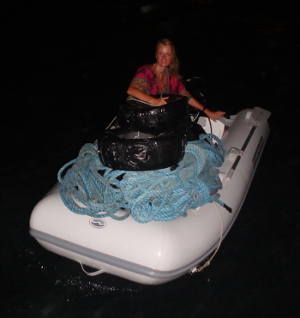
A day later we will return to Colon in the afternoon because we will be doing the first leg of the canal the next day. Everything runs smoothly: We receive the rented long lines and neatly packed car tires, we cover the solar panels so that a thrown line (with "monkey fist") cannot burst the fragile panels, we ensure that the deck is easily walkable and everyone is everywhere can. The next morning our line handlers arrive on time and at the end of the afternoon we sail to the anchorage where we arrived earlier this week, but this time we are a boat covered with tires and awaiting our pilot.
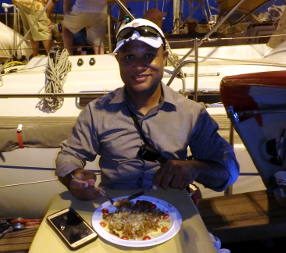
The pilot arrives, a nice man who reassures us with brief business information about what our procedures are. As we had expected, we are transformed together with two other boats into a raft, a very large sailing yacht in the middle and us on the side against it. We only need to operate ONE line as the lines in the front are done by the sailing yacht in the middle protruding far in the front and the remaining line at the other rear is of course taken care of by the sailing boat that is the other side of it. large sailing yacht flanks. We have four line handlers on board, but we only need one.
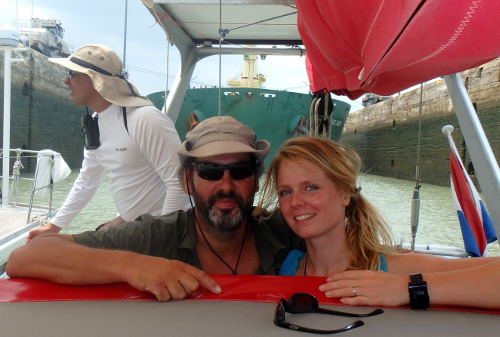
We anchor and enter the canal and 45 minutes later we are in front of the first huge lock. We tie the boats together and when the pilots are satisfied we sail smoothly into the invitingly open gigantic lock gates. The enormous boat in front of us in the lock is connected with lines to six locomotives that are ready about 10 meters higher on the concrete edge of the lock, but our raft has to make do with human line handlers. The enormous lock gates close and the way back is cut off. The water around us begins to churn violently as the incoming fresh water meets the salt water and very slowly we all go up, pulling in our only line bit by bit to keep our raft in the middle of the lock. The operation goes smoothly and is repeated two more times at the next two locks. We have now ascended 27 meters and are in a lake with fresh water! The boats break apart, we drop anchor, the pilot is disembarked and we can celebrate our first leg, said to be the most difficult and dangerous.
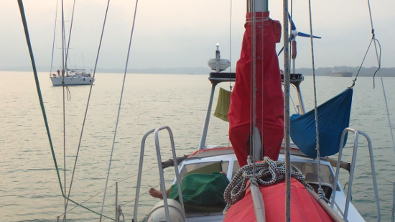
It will be a party because our line handlers are very fun and love a party. Our Panamanian line handlers speak excellent English and while partying we learn a lot about life in Panama. Around midnight we take a dip in the lake (despite the crocodiles), we have a lot of fun and we reluctantly look for a place to sleep. Handy that it is also around 30 degrees here at night so everyone can just sleep somewhere on deck or in a hammock.
The next day we have to get up early because the shed can be brought from about seven o'clock. We are lucky that we can take it a bit easier; at half past eight the pilot boat that brings the man on board arrives. We hit the road immediately because it is another 5 hours to sail down the lake and canal to the locks that will bring us back to sea level on the side of the Pacific. We slowly catch up with the other sailboat that flanked the raft on the other side and we notice that the boat, a larger German ketch, is slowly accelerating. Our pilot says that the pilot on the other boat is a friend of his, but one who always wants to arrive first. We are already sailing 6.5 knots, but I trust our pilot that we can actually be quite a bit faster. He now wants his friend to smell a bit of poo, so we push our throttle further forward. We were already a bit deep in the water because fresh water has less buoyancy and we have so many men on board, but now the propeller pulls the stern even deeper into the water and the bathing platform disappears under water. But it works, we now clock 7.2 knots which is faster than that other boat seems to be able to achieve and we sail past him.
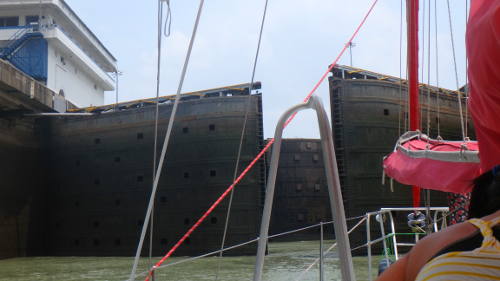
This mischievous region later turns out to have a favorable effect: at the other lock is a medium-sized tourist boat that will be articulated against the wall anyway and two sailing yachts may moor against it. The passed sailboat behind us will now have to wait two hours and we get an extremely easy lock passage where we do not have to operate any line. The atmosphere is pleasant, everyone helps, also in the kitchen, and you would always want to go out with such a crew. The very last lock is a bit exciting because there is a lot of current in the lock and we only have ONE chance to cross the line to the boat next to us; if it is missed, we push the other boat past and according to our pilot we seem to have a real problem. Fortunately it goes well, Ilona steers right next to the ready boat, I have reached out with the line ready on it and on the boat next to us I meet an equally extended hand that takes over the line. A few quick strokes to the cleats, full throttle back, pull the line further in and the back of the boat is solid. The rest is now a breeze and chatting with our crew and those of the boat next to us, we descend the last 30 feet until the huge lock gates open and the Pacific stretches out before us.
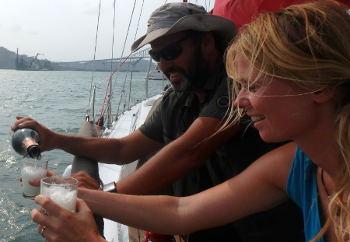

The Pacific is a very different ocean from what we've had so far. There is a cold Gulf Stream here, which we immediately read on our thermometer that indicates a water temperature of 25 degrees instead of the 30 degrees that we were used to by now. In the Caribbean there was hardly any tides, but on this side the difference between high and low water is no less than 5 meters! We anchor at the Balboa yacht club to let everyone off board and collect the lines and tires. We do that anchoring at a depth of 6 meters in a place that is remarkably empty, we anchor a bit deeper than we normally do, but yes, here they have tides and the water will probably drop a bit here. When everyone is off board, we find out exactly how our tide table works and we discover that we anchored exactly during high tide. The water level is now only 3.7 meters, falling steadily, and will end at 1 meter which means that we will end up on the ground! It is already dark but we anchor and look for another place. Getting used to the hassle with those tides!

A day later we move to the anchorage "Playita Flamengo" where the conditions are a bit better. But here too no one lies purely because of the fun. Anyone lying here prepares for a lengthy crossing on the Pacific or for a passage through the Panama Canal in the other direction. But the latter is a minority, because sailing in that direction is not that obvious. Here we meet people who we had already seen who went through the canal just before us and in the following days more and more acquaintances trickle in. There is a local VHF radio and all day long you can hear people calling each other to do odd jobs together, do some shopping, ask for information, and so on. Full of activity. The highlight is when the "Inspired Insanity" walks in after an eight-month uninterrupted stay on the ocean with a 55-year-old solo sailor at the helm. The small sailing boat is primitive, does not even have an engine and therefore needs assistance from fellow sailors to reach the anchorage because it has been windless for days. The brave lady has not spoken to a fellow man for eight months and we will know that too: she is emphatically present on the VHF network. Every morning there is a meeting on the VHF network and the weather forecast is extensively treated by a fellow sailor who specializes in meteorology. In a few days the calm will give way to a steady breeze towards the Galapagos and it looks like this will be the best weather hole of the year. Due to the calm and steady supply from the Panama Canal, the small anchor bay is now packed with boats, and now with favorable weather ahead, everyone is frantically hoarding. Overcrowded dinghies come and go, the taxi drivers are doing good business. Favorite is the Pricemart, a kind of Makro wholesaler for which you need a pass. But many taxi drivers have such a pass here especially for their sailing customers, so it is no problem. You agree on a price and you rent the taxi for a number of hours for about 25 Euro, the driver also wants to help unload the overcrowded taxi and take the things to the dinghy. And those shopping carts are becoming overcrowded, because everyone knows that there is not much to get on the Pacific and that everything - especially drinks - is very expensive. The next opportunity for extensive shopping will be long in coming. Not that Panama is such a great shopping, but compared to what we are going to get we have to be really satisfied. Chris, our Panamanian linehandler, helps us with our purchases, because he has his own company that trades in fruit and vegetables, so he knows a lot about it. If you want his help (highly recommended !!) please contact +507 6232-5045 (whatsapp)

As soon as we have finished shopping, we want to leave Panama city anyway because the anchor bay is not that beautiful but it is expensive, at least, to be allowed to moor the dinghy (50 euros per week for the dinghy jetty and less than a week is not allowed ). We want to wait for good weather and further prepare the boat on the Las Perlas archipelago, just off the Panamanian coast. Because the Panamanian couple that acted as a linehandler for us is so pleasant and helps us so well, they can sail with us to Las Perlas. They take care of all the food on board and that way we get to know some more Panamanian dishes. It is going to be a lot of fun again, but after two days we have to say goodbye again because our Panamanian friends have to go back to work. They return by ferry and we prepare for our first multi-day crossing on the Pacific. The destination on paper is the Marquises, but we pass the Galapagos Islands and we hope to get permission to spend some days there. It is not entirely certain yet, but in principle we can sail straight on to the Marquises.
Cruiser Manual
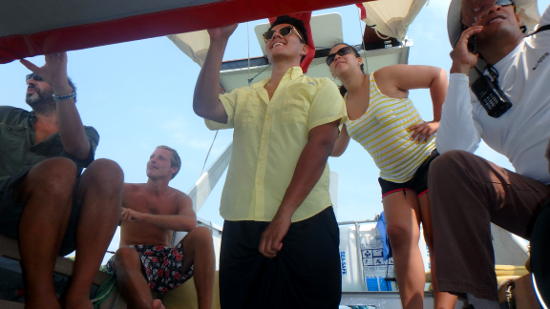
If you prefer to moor in a luxury harbor for only $ 50 a day, instead of anchoring on a river where you are awakened by screaming parrots and roaring monkeys in the morning before dawn, you prefer to hire an agent for convenience organize the whole Panama Canal process for you rather than tire yourself out? Then this guide is not for you. The rest should read on and save about $ 1300 altogether. Without an agent is no slower than with an agent; in fact, we were through the channel before a couple arrived at the same time as us and hired an agent!
This manual is intended to supplement the information you can find in the Bauhaus guide, among other things, and only relates to arranging the formalities, saving money and designating a much nicer alternative as a waiting place than the designated port. We assume that you are already familiar with the practical state of affairs in the Panama Canal.
The name "Tito" is mentioned a number of times in this manual. This is the local hustler who has men and relatives everywhere and knows what to do about everything. He speaks good English, is reliable and fun to talk to. "Tito" is a household name, everyone knows him, so you can just ask or refer to "Tito" anywhere. Everything is cheaper through him, renting the car tires and lines, customs clearance, and so on.
- It is useful to fill in form 4405-I (www.pancanal.com/eng/op/forms.html) in advance and email it to OPTC-ARA@pancanal.com (tip: PDF files can be conveniently fill in and save online using this website: http://www.pdfescape.com/). This form is necessary to continue with the process and it costs nothing to submit it in advance. You are then in the system and once in Panama you can start right away.
- You will probably go to San Blas beforehand. Do not clear customs but visit the islands to your heart's content. It is tolerated to sail around San Blas and land on the islands without clearing, as long as you do not go ashore. Buy a local phone card (Digicel) in Narganana and make sure you can use the internet, make calls and send text messages. At the Panama Canal you will have to make some calls and use the internet to arrange everything. If you want to save money, don't go on Porvenir, it will cost you about 500 dollars, but wait until you get to Colon. There it will only cost you 100 dollars if you use the service of "Tito". We suspect that this step is not completely legal ...
- Sail to Colon, a nice stopover is Isla Linton. As you approach the breakwater, call Christobal Signal Station on VHF 12 and announce that you are on your way to "The Flats" aka "Anchorage area F". Once inside you sail straight to "The Flats" and drop your anchor there. There is nowhere to land here but you have to be here to be measured and inspected by the admeasurer.
- If you already knew on which day you will arrive, it is best to inform us by e-mail (same email address where you sent that form). You cannot make a time appointment and on the day of the measurement you have to be there at 7 o'clock because from then until early afternoon is the period in which the admeasurers are brought with a pilot boat for a long time. If you want to be measured on Wednesday, you have to email that you will be there on Tuesday, or that you will arrive on Wednesday before 7 am. Many people do not receive an email back, but the admeasurer will come. The admeasurer measures the ship and fills in the papers together with you. You sign some forms, including one in which you declare that your boat does not meet the Panama Canal requirements but that you want to pass through it at your own risk (this is a standard declaration that you cannot ignore). And you will also receive a form with which you can go to the bank to pay the money for the transit, only when that amount has been paid, your transit can be scheduled by the scheduler. Note: it is important that your boat can at least 5 knots! Can you 4.9, then lie. Do not exaggerate the other way, if you say that you can do 7 knots and in reality it turns out that you only get 6, then a (high) amount will probably be taken from the deposit! There must also be a toilet on board and a greywater tank.
- Now sail to "Club Nautico" and drop your anchor there. Call Tito (+ 507-64635009) to make an appointment in advance for the car tires and long lines (and possibly the customs clearance). You can also inquire about "line handlers" at Tito, but you can also get there for free, see below. If you want to go to the Galapagos after passing the Panama Canal, you need a "fulmination report", normally costs $ 250, but Tito $ 50.
- Drive a taxi past the banks and pin the amount together for the payment of the Panama Canal (that is not possible at the bank where the money must be paid! You can transfer it but it takes 5 days). When the amount is complete, go to the City bank, there is a special counter for the Panama Canal, and pay the required amount. You can call the scheduler later that day (that number is on the information letter you received from the admeasurer) to find out when you are scheduled (they say you can only call in the evening but they already know before noon and you just get an answer when you call)
- You need a skipper and four line handlers. If you are sailing around as a couple, you need three additional line handlers. Now those four line handlers are really only necessary in theory, because you go through the canal as a raft of several boats, where only the outer boats need line handlers and then also two more, or tied to a tugboat where you only need two line handlers. So you don't need to have four "experts" on board. There is a radio on VHF 77 where you can make arrangements with other boats to act as line handlers for each other, you can also approach the other anchored boats at Club Nautico to see if anything can be arranged. There is also a website (www.panlinehandler.com) where you can place an ad that you are looking for line handlers and there is a section where people have signed up as line handlers. This includes people with and without experience, if you already have two skilled people on board who know how to hold a line, then of course you do not necessarily have to bring someone with experience because the chance that such a person has to take action is almost nil. Because of this website we actually had too many people in no time, so we had to disappoint some people here and there. It is a special experience for many people to go through the channel and it is not at all strange that someone does it without receiving a financial compensation. Make sure you have fun, good food and drink!
- Everything ready and still waiting for the transit date? Our advice: raise your anchor and sail out. Six miles to the southwest is the Rio Chagres, a river that runs through the rainforest. Look carefully at the map for the shallows at the entrance, but otherwise the still (dammed) river is free of obstacles and shallows. Sail in, drop your anchor and wait for the monkeys (especially) to emerge in the evening and morning. Especially in the morning you can hear the roar of the monkeys, the screeching of the parrots and all kinds of other jungle sounds. Watch out when swimming because crocodiles also live there.
- The afternoon before your scheduled transit you will return to club Nautico. Call the scheduler to find out if you are still scheduled. You pick up the car tires and lines and prepare the boat. The next day, your line handlers should drop in. Call the scheduler again. At the end of the afternoon you will sail to "The Flats" and wait there for the pilot to arrive. Good luck with your transit!
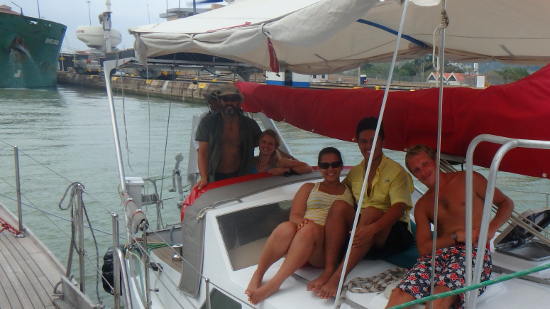
Savings so far: $ 400 in clearance fees, $ 300 in agent fees, $ 400 in line handlers, $ 200 in fumination report fees. Total savings of $ 1300!
